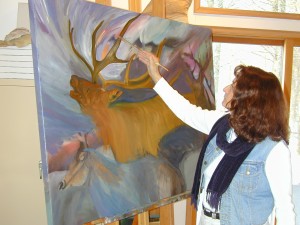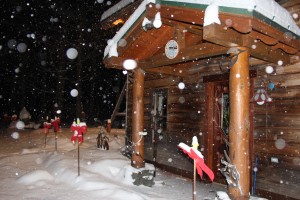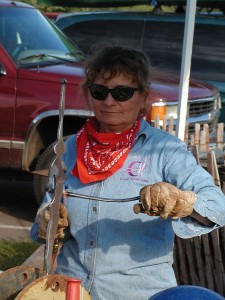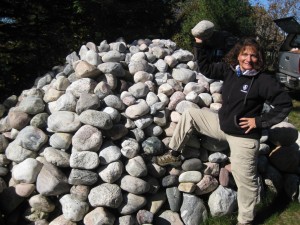Up North Woman Magazine
2005 premier edition
by Paul Mitchell
It would be nearly impossible to walk away from an encounter with artist Sara Balbin without feeling energized. Sara is a dynamic force among Up North women. Her sculpture is some of the most visible and well-known in northwest Wisconsin. She has shared her talents with the Lac Courte Oreilles people, painting captivating portraits of LCO elders which hang in tribal public buildings and which have been used in a visually stunning historical book about the LCO reservation and people. She mentors local students in the arts and works as an art therapist, encouraging people to draw from their own inner strength and beauty. Sara has a gift for spreading her seemingly boundless energy.

Sara has a passion for painting
From Cuba to Chicago
Born in Cuba, Sara and her family emigrated to the U.S. when she was a young child, settling in Chicago where they lived in a one-bedroom basement flat as they adjusted to life in America. Sara’s father, Gilberto Balbin, studied mechanics and earned a position as a Union Technical Mechanic with Chrysler Corporation, specializing in mechanical problem solving. Corinda, Sara’s mother, studied at the Art Institute of Chicago for clothing design, pattern making and fashion consulting, which led to a successful career. She is busy as a fashion consultant to this day. “They are my heroes,” Sara says. Her own skills as an artist are reflected in her parents’ individual gifts. Gilberto paid meticulous attention to each detail in his work. “To him, the car was like a human being.” An artistic mechanic. “I acquired my confidence with tools and problem solving from my father,” she surmises. The design aspect of her work and the manipulation of steel in her sculpture fabrications is similar to her mother’s training in dress making and design, she says.
In Chicago, Sara grew up feeling like an outsider, an experience which had a profound affect on her. “One of the things you have to learn in the arts is to live with rejection and be comfortable with it,” she says. “And if you can’t work alone, you can’t be productive. You have to enjoy your own company.” Sara remembers her initial leap into the world of artistic endeavor. “It may sound corny,” she says with a smile, “but I remember when I was six or seven, I cut a rabbit out of yellow construction paper. And that was the beginning of my passion for the arts. Something struck me.” Her talent was recognized and she began her studies at the Art Institute of Chicago as a teen, studying art history and the visual arts. Sara feels lucky to have been allowed to indulge in the arts at such an early age and to be mentored by so many wonderful, talented and accepting adults, many of whom are good friends to this day.
As a student Sara was primarily a painter, although she did a bit of sculpting too. Her artistic repertoire began to evolve when she made the move from urban Chicago to the wilderness of northwestern Wisconsin, taking up residence in a rustic cabin, nestled on the edge of the Chequamegon National Forest. The reality of living in the forest with no electricity or running water influenced the type of sculpting she was able to do. Sara had to use an oxygen acetylene torch to fabricate, so steel replaced bronze as her sculpting material. She also could no longer used castings that required large quantities of water. “But I made the decision to live here out of a sense of adventure,” she says.
An adventure it was. Sara lived in her cabin in the forest for more than five years. There were winter mornings when she had to shovel snow from inside the drafty cabin. Summer nights when she had to sleep in a tent inside the cabin because there were so many mosquitos. “I love adventure, and living up here is an adventure, among the elements, in this environment. I love life, and I love feeling alive.”

A snowy night at Dragonfly Studio
Artistic passion
Sara’s steel sculpting involves as much mechanical engineering as it does artistic vision. “When I’m wrestling steel,” as she calls her sculpting process, “it’s very physical, heavy work.” Although Balbin is fit and accustomed to a life of Northwoods adventure, she doesn’t appear at first glance to be likely to do heavy steel fabricating work. Until, that is, her inner energy shines through. Her ability to tackle the seemingly impossible can be understood through one word: Passion.
“When I’m alone, and the passion hits, I don’t know how to stop myself. The passion gives me the energy and the drive to create the work.” New pieces begin not in the studio, but in Sara’s imagination. “Before I come into the studio, the night before, I’m creating in my mind. I visualize to myself how I’m going to create the piece. “By the time I get out here,” she says, referring to the studio and workshop located a few dozen yards from her home, “the focus and energy is just here. I could almost open the door to the studio without touching it.”
An important key to her own artistic life, Sara feels that the most empowering thing for any artist is self discipline. “All of the arts, including writing and dance, are called ?disciplines,'” she says. “It takes a phenomenal amount of discipline to create.” Sara’s two-story “Dragonfly Studio” is a reflection of her varied talents as an artist. The first room, a reception area for visitors and gallery owners, showcases her eclectic body of work including finished sculptures in steel and leather, lamps, a steel-sculpted chair and paintings.
Upstairs is a light-filled studio with large windows facing the forest and a lake, giving it the feel of a spacious treehouse. The room is filled with finished life-sized leather sculptures, books, supplies, a collection of skulls and bones, and an easel cradling a work in progress, an oil painting of Chequamegon forest elk, the Northern Lights shimmering among their antlers.
Downstairs, behind the reception room, is her tool-filled workroom, feeling more like a welder’s workshop than an artist’s studio. This room exposes the very physical and technical nature of much of Sara’s steel sculpting. The workshop has a large set of double doors that open to an outdoor covered workspace, where Sara sculpts summer and winter, when she uses snow to cool the freshly-cut steel.

Wrestling steel into creative results
This project began years ago when Sara opened her first art studio in the village of Old Hayward, a collection of historic buildings moved to a site on the shore of Lake Hayward by visionary Tony Wise. Old Hayward became a haven for artists and craftsmen and attracted large numbers of tourists.
Sara thrived in this unique community not only of artists but also of Ojibwe people who lived on the grounds. Her studio was adjacent to the Ojibwe pow wow grounds at Old Hayward. “The power of their songs, dance and culture attracted me from the beginning,” Sara writes in the introduction to the book, Spirit of the Ojibwe: Images of Lac Courte Oreilles Elders. Sara formed friendships with many LCO tribal members, who would stop by her studio to visit. During these visits many would pose for paintings and sketches as they talked.
A special connection blossomed with James “Pipe” Mustache Sr., the spiritual leader of the Lac Courte Oreilles. Pipe educated Sara on the customs of the Ojibwe people. She and Pipe would often travel to the communities of the LCO reservation together where they visited with people and shared in their music and culture.
Sara continued her work on the portraits of the LCO elders and became the artist in residence at the Lac Courte Oreilles Ojibwe school. The studio in the art class at the school provided a place where elders, their families and students could visit and observe the progress of the paintings. While in the studio, elders also shared oral histories, which became the basis for images in the allegorical portraits and for written biographies which now accompany the portraits where they are displayed in the new Tribal Cultural Center at the LCO Ojibwe Community College and in the book.
The book, which has been six years “in the works,” Sara says, has been written and compiled sharing the talents of LCO Tribal members Thelma Nayquonabe and David Bisonette and writer James Bailey. A grant through the Outagamie Charitable Foundation paid not only for the publishing of the book, but also for copies to be given to the families of the elders of LCO, museums, libraries and schools in the region. In addition to the portraits and oral histories, the book also incorporates photos and maps to give a historical perspective of the many very distinct communities which make up the Lac Courte Oreilles reservation.
Her parents, both active in various Masonic organizations, also influenced her desire to serve, and today she follows in their footsteps by working with young people herself. When she was an art student, Sara says, there were “many people in my court who were helping me.” She carries on that tradition by mentoring young artists, sharing her passion and her drive. “Students come to my studio,” she explains, “to work with me and to watch me work. They see how grungy I get, out there sweating in my Carhartts. They see that the artistic process is not always comfortable. It’s all very exciting at the conception of a piece, but it takes hard work and a lot of time to create.” The students learn, though, that the work is worth the effort. “The reward is the finished product.” Sara encourages students to find outlets for their own work. “I network for them, help to get them out there. I try and set the stage for them to have some success.”
Sara has taught courses at the LCO Ojibwe School, at Northland College in Ashland and is now working with the Ascend Academy in Drummond. After the birth of her daughter, Sara returned to school and earned a master’s degree in Art Therapy. Today she helps people to heal through their own artistic endeavor. “It’s a very giving profession,” she says, “and it gives me balance in my life. “‘Sara producing’ has to be balanced with ?Sara giving’.”
Even for an accomplished and energetic artist like Sara, there are times when her artistic process gets strained or difficult. “When I find it’s not coming together, I have to tell myself to let go. To let the process take over.” She steps back, lets go of the very deliberate aspect of creating, and lets her inner artistic process take over. “Then the piece develops as it should. When you let it go,” she says, “then you find that you are where you should be.” And Sara Balbin is certainly where she should be.

Elements of nature abound in Sara’s works
Sara Balbin’s large sculpture can be seen in the village of Cable at the Cable Natural History Museum, the Cable Community Center on Highway M and in front of the State Bank of Drummond; also in Ashland at the Memorial Medical Center and in Spooner at the Spooner Memorial Library. Her work is available in numerous area galleries, including Art Beat in Hayward, the Black Iris in Spooner, Outdoor Ventures in Hayward, Firefly in Cable, the King’s Ideal Market in Cable, Superior Gallery in Washburn, Stone’s Throw in Bayfield and the Phoenix Gallery on Madeline Island.
She is currently creating a sculpture park in the forest surrounding her studio and home where she lives with husband Gary Crandall and two children, Eric and Melisa. The park will be available for periodic tours beginning the summer of 2005.
Social artistry
Although Sara’s artistic process requires a love of solitude, her life and her art are also heavily influenced by her very social nature ? a reflection, she says, of her Cuban cultural heritage. One of her on-going projects is a result of her ability to channel this energy into her art. Sara has been painting portraits of Lac Courte Oreilles Tribal Elders for many years and is about to publish a book to share the paintings and the personal stories of these elders, many of whom are no longer living.


Dear Sara
I stopped over to see Corinda your mom yesterday because she was very dear to me thru the years when I lived in Morton Grove. My mother in law was ESTER BRESSLER MARRIED TO JUDGE NOVOSELSKY and we both had mom do our alterations.
Mom was cautious to open the door?.but she did and I sat with her for about 45 minutes to talk with her. Can you update me with her situation since she did not remember anything or anyone. I have a small therapy dog and she loved petting her while we talked. I was hoping she would have some recall but as the conversation went on she started to remember. What a sweet lady? I am sorry that she didn’t remember me or mom but I will visit her again and try. It makes me so sad because she was such a hard worker and a special lady that I loved to talk with. I knew all about you and your art?. your brother in Miami and his children. Sorry about your dad I read the obituary but I was out of town. I am living in Lincolnshire Illinois and go into Morton Grove with my Sugar to classes for doing hospital therapy and nursing home visits.
Dear Judi,
Apologies for the delayed reply to your message ? for some reason my web page comments are not coming through to my email inbox and I just today discovered your message.
It pleased me to learn that you dearly care for my mother Corinda, and that you and your doggie made the effort to visit her…. how sweet!
After my father’s passing, my mother’s wish to clean the household; he was a collector and she is a utilitarian. Not wishing to disturb his comfort in his later years she permitted him to collect all the books and magazines he loved reading. After his passing, her mission has been to clean and prepare for her own passing. Her children feel blessed having her at the stern. Our youngest “single” brother Gilbert lived a few blocks away, and it was logical that he move in with her. This has been a blessing and actually has kept our mother mentally stimulated and engaged during the remodeling of the kitchen, bathroom, bedrooms living, dining room, porch and garage. They are now in the process of remodeling the lower level and recently installed a complete bathroom.
To acknowledge what you experienced; the first day my husband Gary and I arrived during the Thanksgiving holiday, my mother was attentive, but was not following the conversation. As it turns out, she “hates” wearing her hearing aids; this distanced her.
I call her almost everyday, and sometimes twice a day to connect. Today I learned that her long term friend Evelyn Lamb passed, and the funeral is tomorrow. This is a significant time in my mother’s life, and I hope that you can reach out to her in the near future to bring her comfort.
Judi, I’m grateful for your dedication to my mother Corinda, and please bring your sweet doggie to visit her again.
Lovingly,
Sara